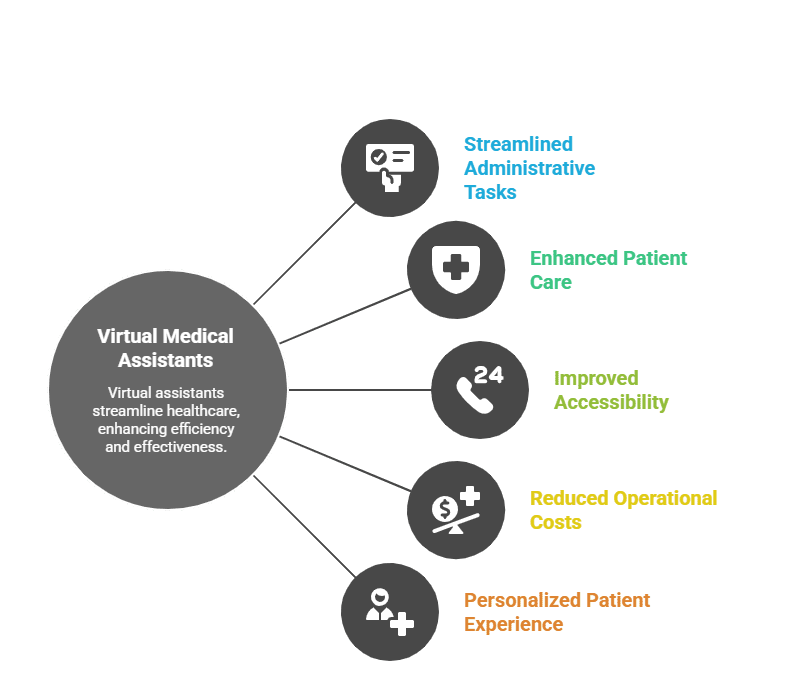On-Demand Outsourcing BPO Services for Healthcare Providers With 24/7 Coverage!
Save up to 70% on staffing costs!
Browse Specialty Staffing ServicesThe Rise of Virtual Medical Assistants: Transforming Healthcare

In recent years, healthcare has seen significant advancements driven by the adoption of digital solutions designed to improve efficiency, reduce costs, and enhance patient care. One of the most innovative technologies transforming healthcare today is the rise of AI-powered administrative assistants. These tools are revolutionizing the way healthcare providers operate by automating routine tasks, streamlining workflows, and allowing healthcare professionals to focus on what matters most—delivering high-quality patient care.
The Rise of AI-Powered Administrative Tools
What are AI-Powered Administrative Tools?
AI-powered administrative tools are intelligent systems designed to assist healthcare providers by automating various administrative and clinical tasks. These tasks can range from scheduling appointments and answering patient inquiries to managing medical documentation and processing claims. By automating these repetitive tasks, these tools allow healthcare staff to save time, reduce errors, and increase overall productivity.
Key Benefits of AI-Powered Administrative Tools

-
Improved Efficiency
One of the primary advantages of these tools is their ability to handle time-consuming administrative tasks. For example, managing appointments, processing patient records, and sending follow-up reminders can be automated, allowing healthcare professionals to spend more time on direct patient care. These tools can also manage multiple tasks simultaneously, improving workflow efficiency in busy healthcare environments. -
Cost Savings
By automating routine tasks, these tools reduce the need for additional administrative staff, which can lower labor costs. Healthcare practices, particularly small to medium-sized ones with limited staff, can benefit from cost savings while maintaining a high level of efficiency. -
Enhanced Patient Engagement
These tools facilitate better communication between patients and healthcare providers. They can remind patients about upcoming appointments, answer frequently asked questions, and provide general health information. With access to assistance at any time, patients enjoy an improved experience and greater satisfaction with their healthcare. -
Data Accuracy and Compliance
These systems are designed to handle data with high precision, minimizing human error in medical documentation. They can assist in transcribing medical records, coding diagnoses, and ensuring that all information is accurately entered into digital systems. By automating these tasks, healthcare providers can maintain compliance with industry regulations, such as patient privacy laws, ensuring data security and accuracy. -
Scalability
As healthcare organizations grow, the volume of administrative tasks increases. These tools are highly scalable, meaning they can handle higher demands without the need for significant changes in infrastructure. This makes them suitable for both small practices and large healthcare systems.
How AI-Powered Administrative Tools Work
These tools are typically cloud-based and integrate with existing healthcare systems such as electronic medical records (EMRs) and practice management software. They leverage machine learning and natural language processing (NLP) to understand and respond to voice or text-based inputs from both healthcare providers and patients. For example, a healthcare provider might dictate notes into the system, and the tool will transcribe and organize them accordingly. Similarly, a patient could send a text or speak to the assistant to schedule an appointment or inquire about their treatment plan, and the tool would respond with relevant information.
Challenges and Considerations
While AI-powered administrative tools offer many benefits, their implementation comes with some challenges. One key concern is integrating these systems into existing healthcare infrastructure. It is essential that these tools work seamlessly with current systems like electronic medical records (EMRs), billing software, and patient portals to avoid disrupting daily operations.
Another challenge is the need for continuous updates and training. As technology evolves, these tools require regular learning and updates to adapt to new medical knowledge and operational improvements. Healthcare providers also need to ensure that the tools are trained to handle patient data securely, with a strong emphasis on maintaining confidentiality.
The Future of AI-Powered Administrative Tools
The future of AI-powered tools in healthcare is bright. As AI technology continues to advance, these systems will become even more sophisticated, potentially taking on more complex tasks such as assisting with diagnostic support, patient monitoring, and even virtual consultations. With healthcare continuing to focus on value-based care and improving patient-centered practices, these tools will play a critical role in improving access to care, reducing wait times, and enhancing patient outcomes.
What Did We Learn?
AI-powered administrative tools are transforming healthcare by automating routine tasks, improving efficiency, reducing costs, and enhancing patient engagement. These tools have the potential to significantly improve the quality of care and streamline the operational processes within healthcare organizations. By adopting this technology, healthcare providers can stay ahead of industry trends, offering more efficient, cost-effective, and patient-focused services.
What people are asking?
-
What is an AI-powered administrative tool?
An AI-powered administrative tool is a system designed to help healthcare professionals manage routine tasks such as scheduling, answering patient questions, handling medical documentation, and assisting with coding and billing. -
How do AI-powered tools improve efficiency in healthcare settings?
These tools automate repetitive tasks, allowing healthcare providers to focus on patient care. They manage scheduling, record keeping, and follow-up reminders, which streamlines workflows and reduces the time spent on non-clinical duties. -
Are AI-powered tools secure?
Yes, these tools are designed with security in mind, particularly in healthcare environments where patient data privacy is crucial. They are built to comply with industry regulations, ensuring that patient information is securely handled and protected. -
Can AI-powered tools integrate with existing healthcare systems?
Yes, these tools are typically cloud-based and can integrate with existing healthcare systems like EMRs, billing software, and practice management systems, ensuring seamless operations within your current infrastructure. -
Do AI-powered tools replace human healthcare staff?
AI-powered tools are designed to assist healthcare staff, not replace them. They handle routine administrative tasks, allowing healthcare professionals to focus on more complex, patient-centered activities. Human oversight is still necessary for clinical decision-making.
Disclaimer
For informational purposes only; not applicable to specific situations.
For tailored support and professional services,
Please contact Staffingly, Inc. at (800) 489-5877
Email : support@staffingly.com.
About This Blog : This Blog is brought to you by Staffingly, Inc., a trusted name in healthcare outsourcing. The team of skilled healthcare specialists and content creators is dedicated to improving the quality and efficiency of healthcare services. The team passionate about sharing knowledge through insightful articles, blogs, and other educational resources.
 Book a Demo to Build Your Team Today!
Book a Demo to Build Your Team Today!

 Read Case Studies
Read Case Studies 



 Virtual Medical Assistants
Virtual Medical Assistants



